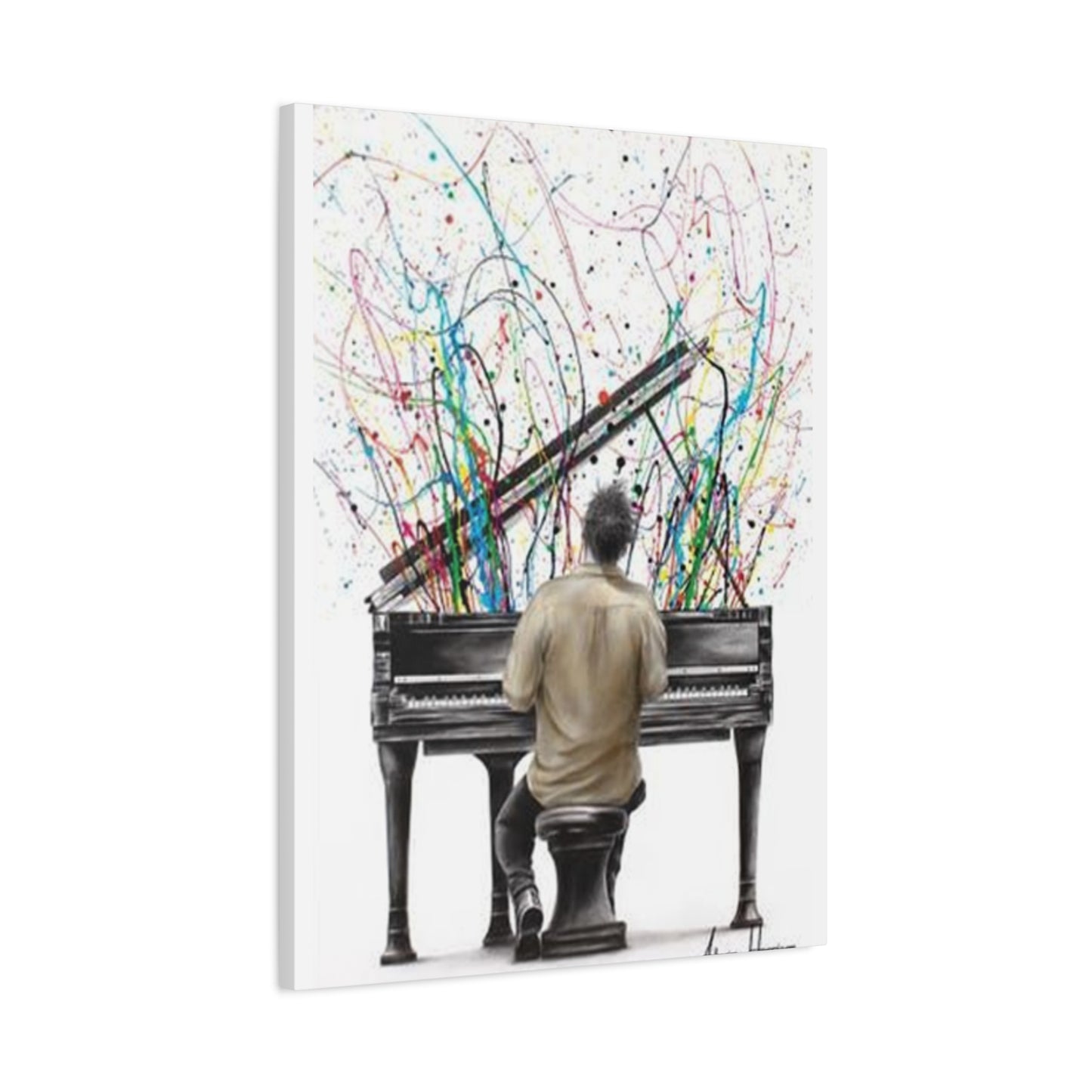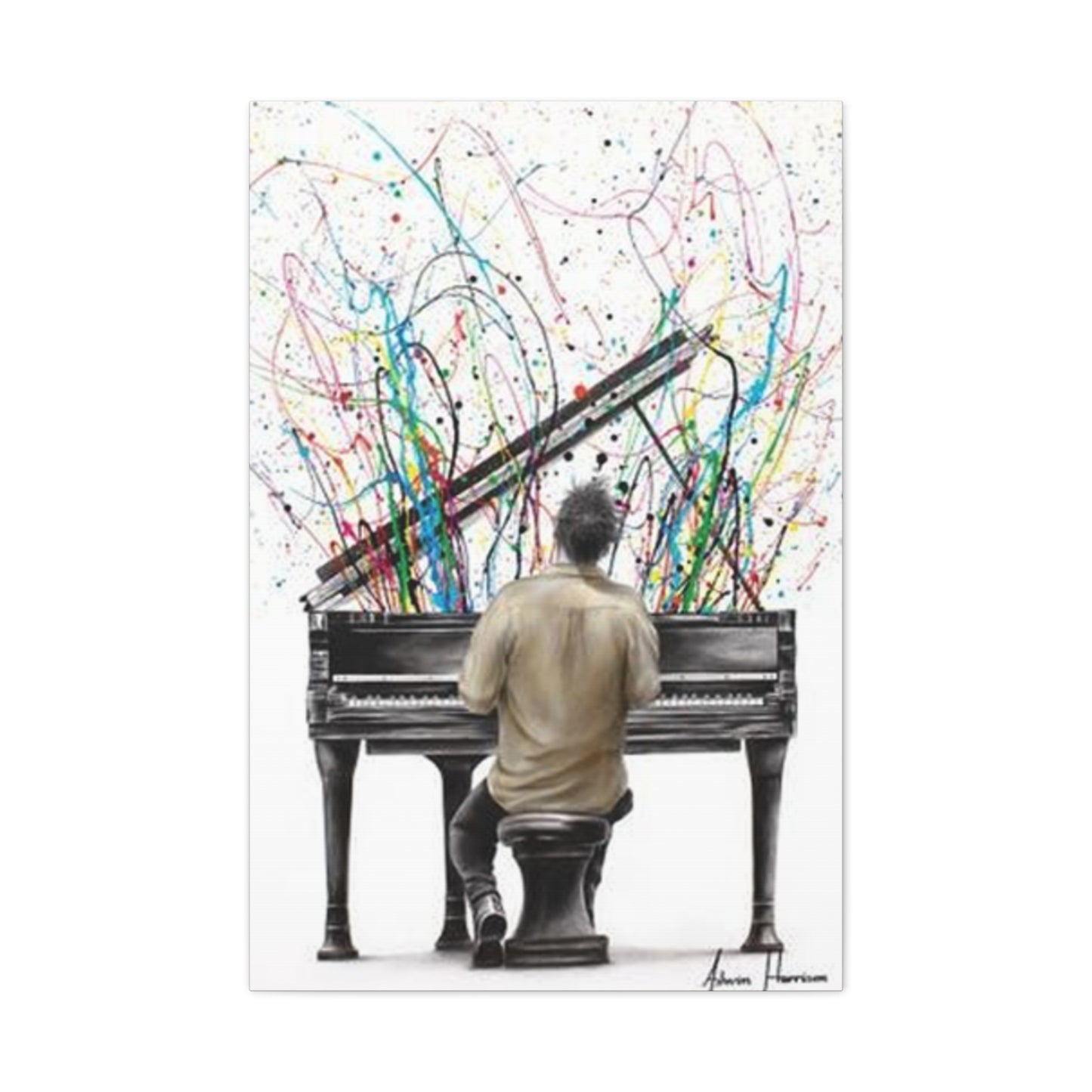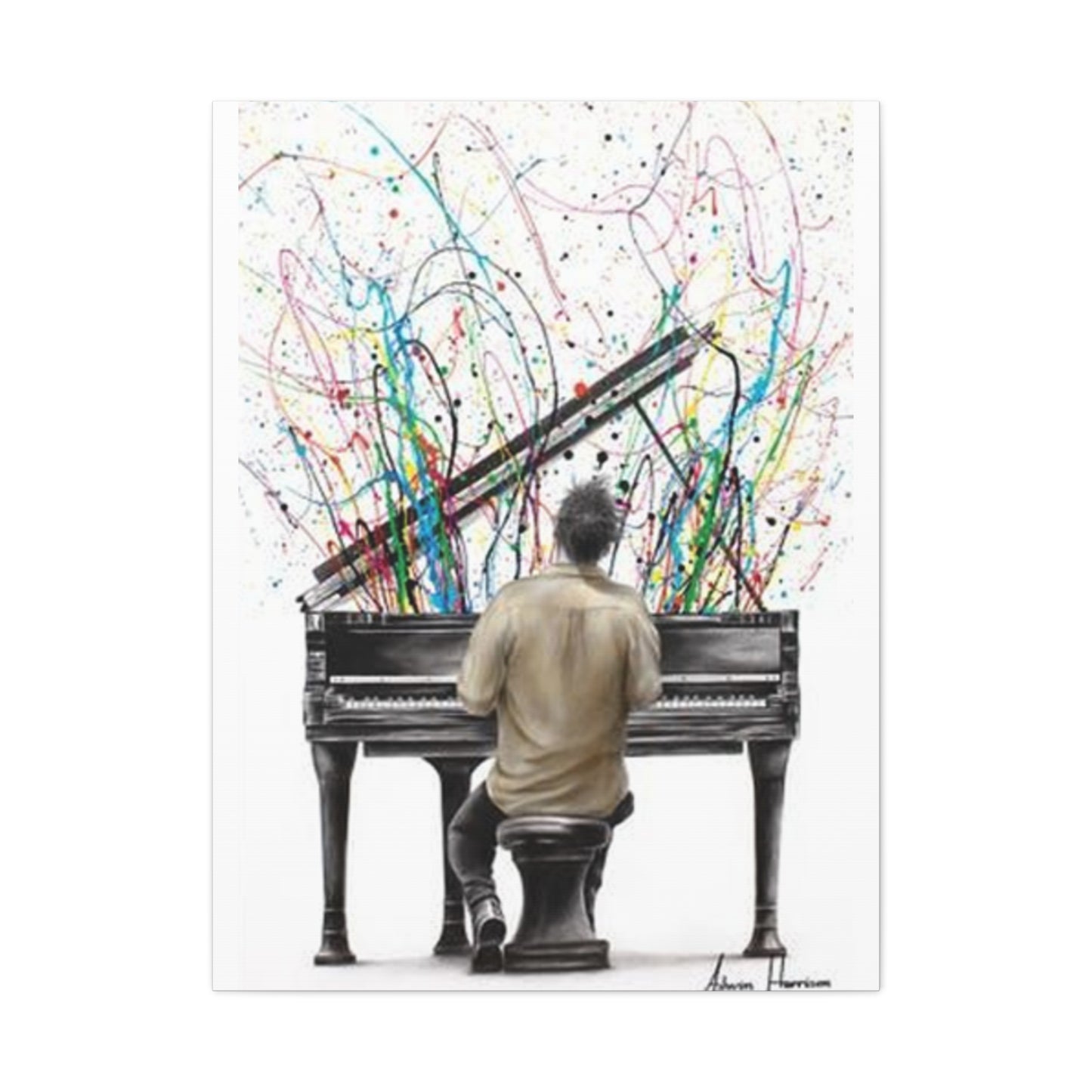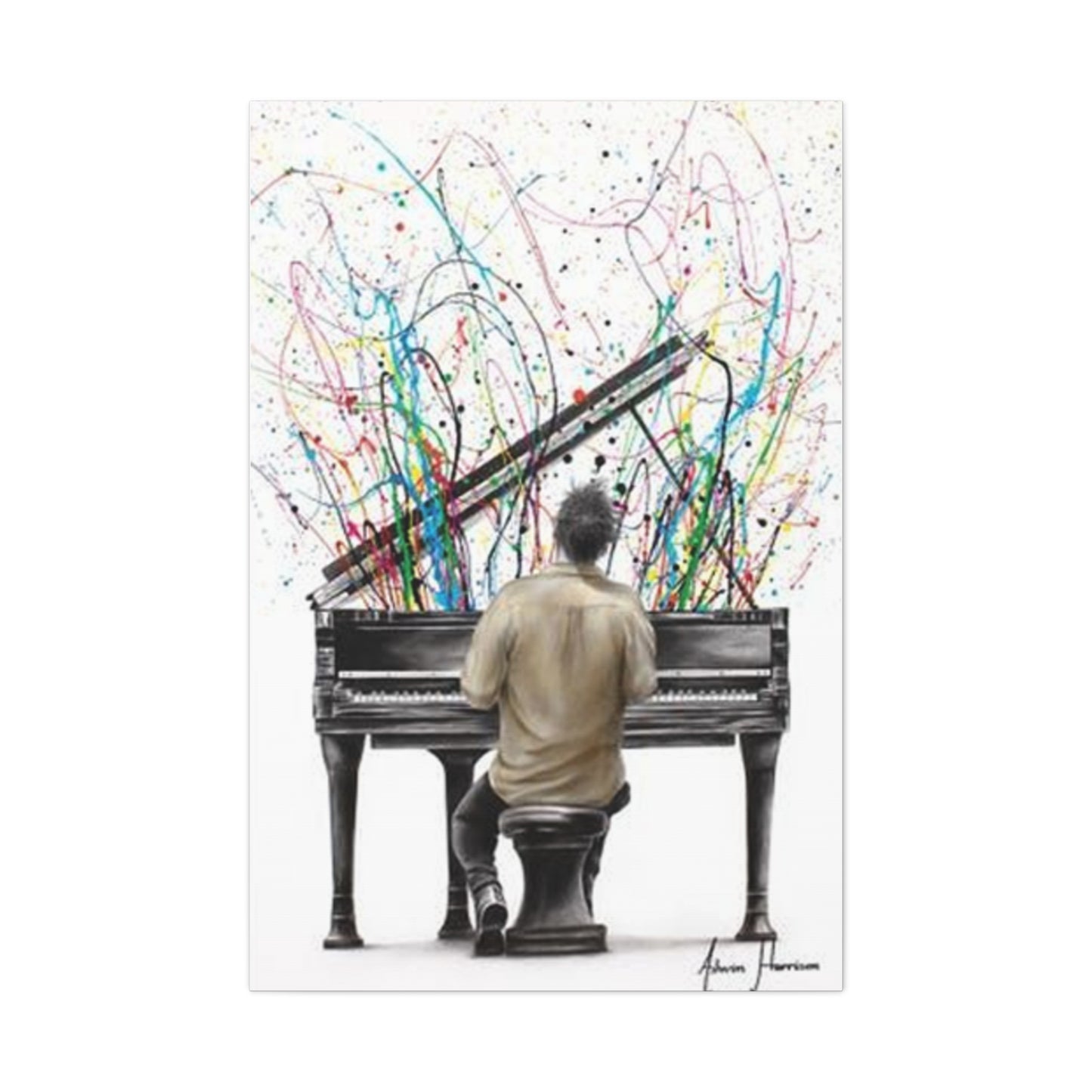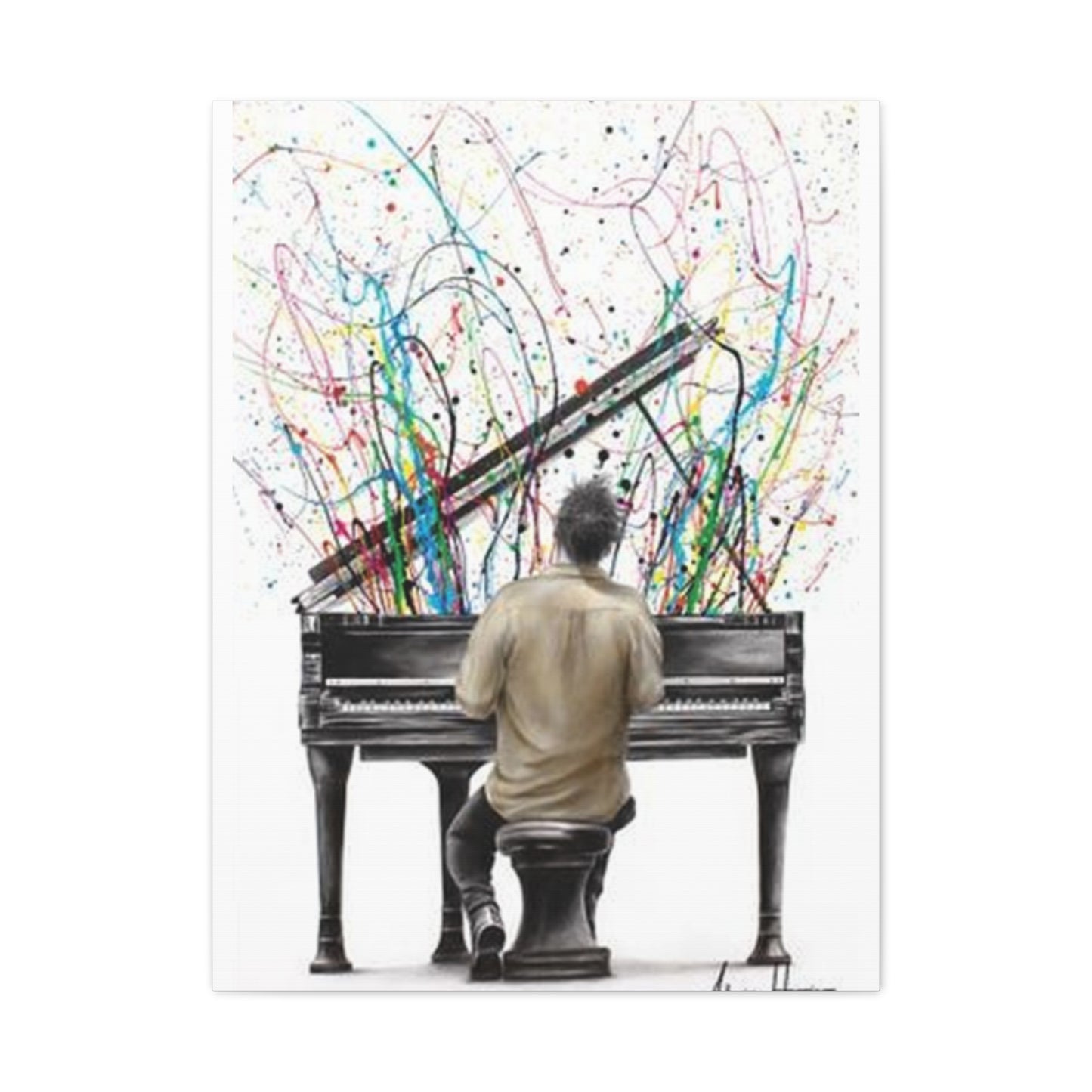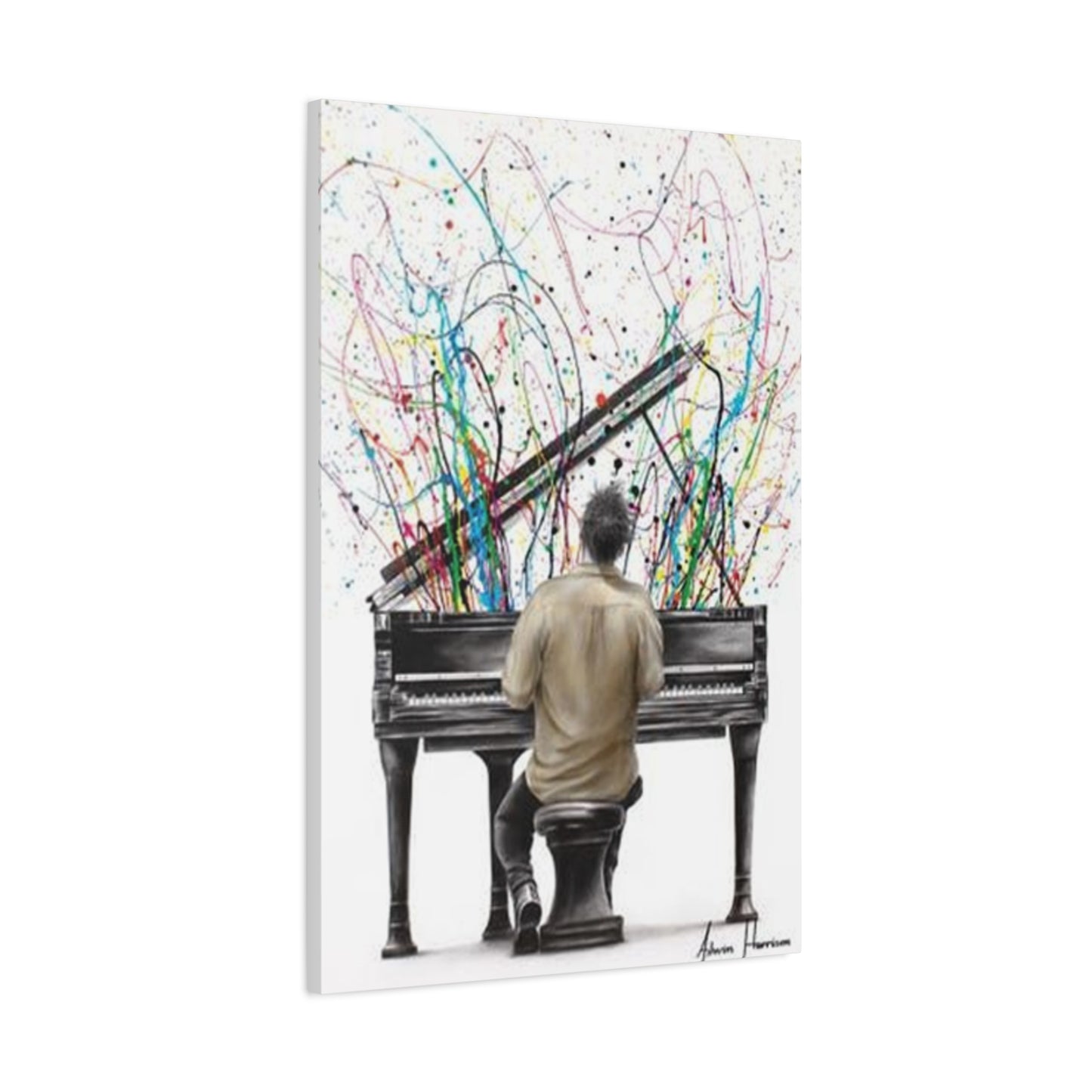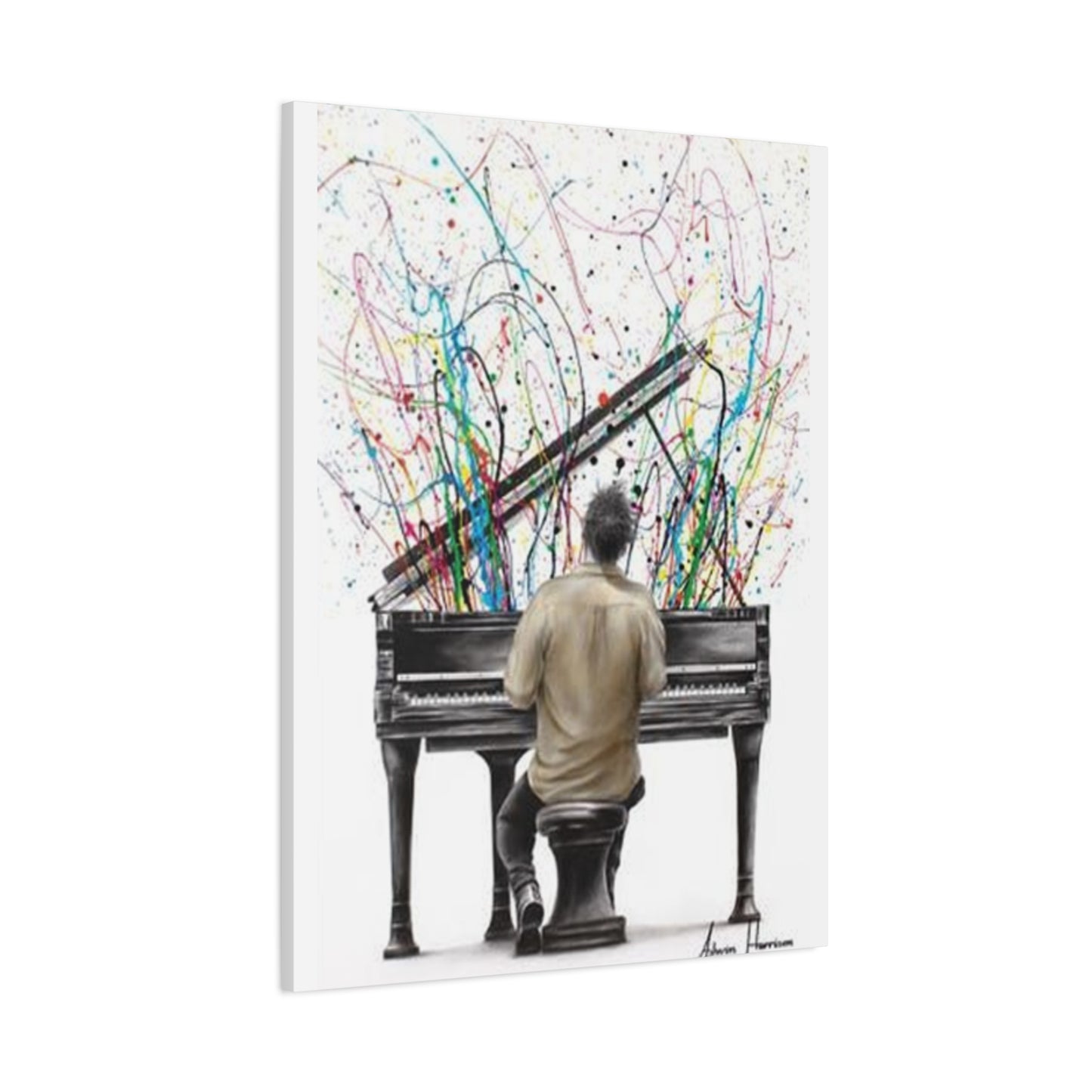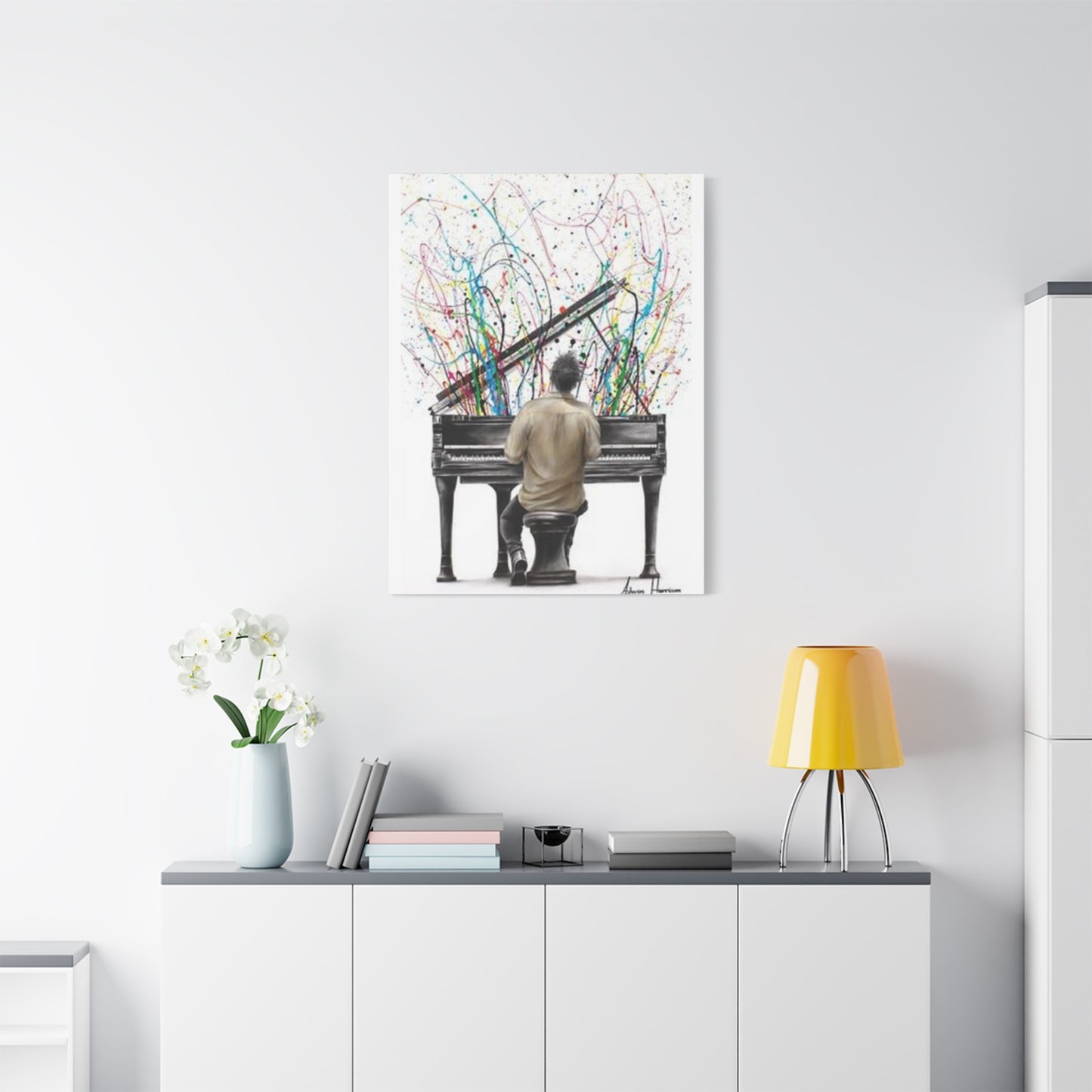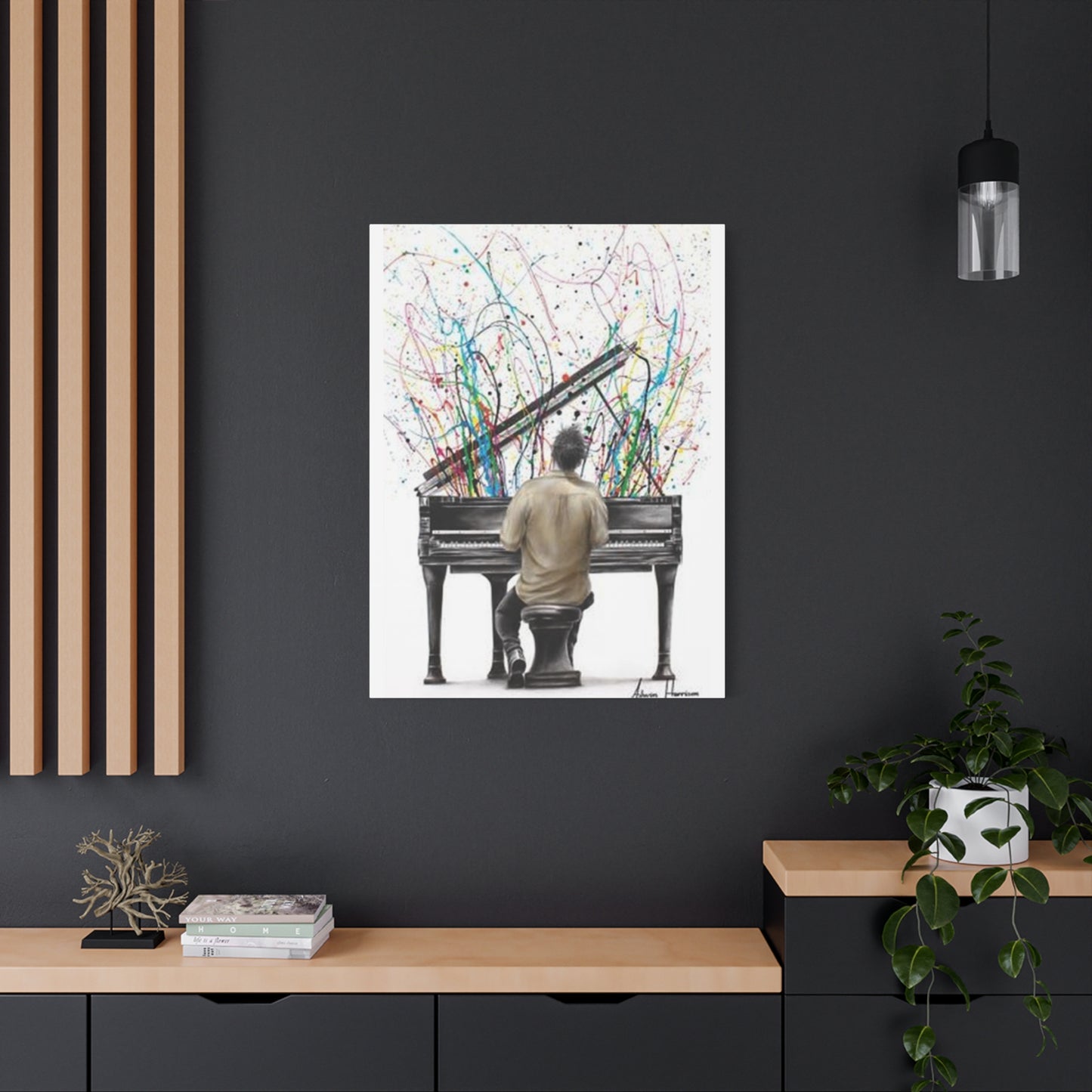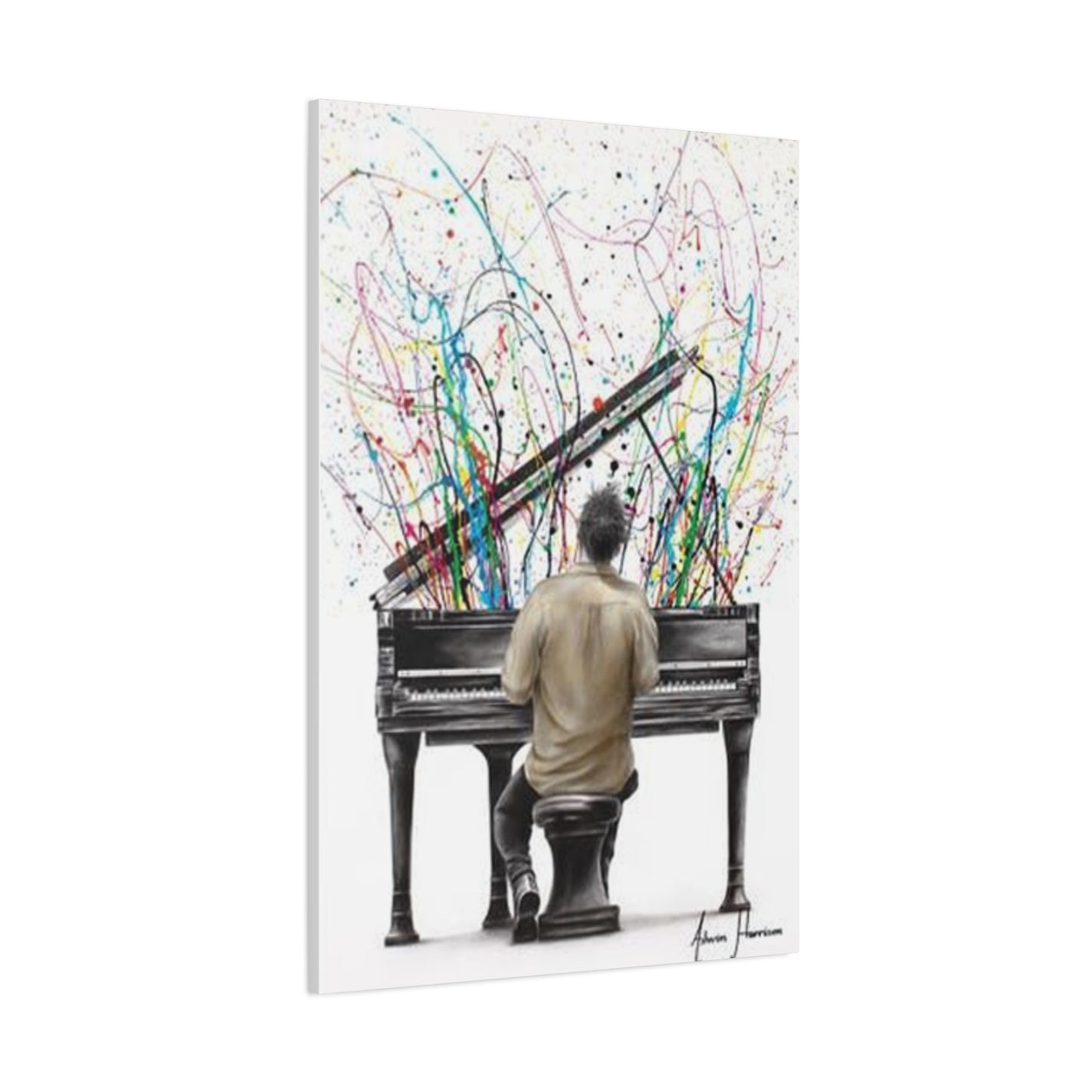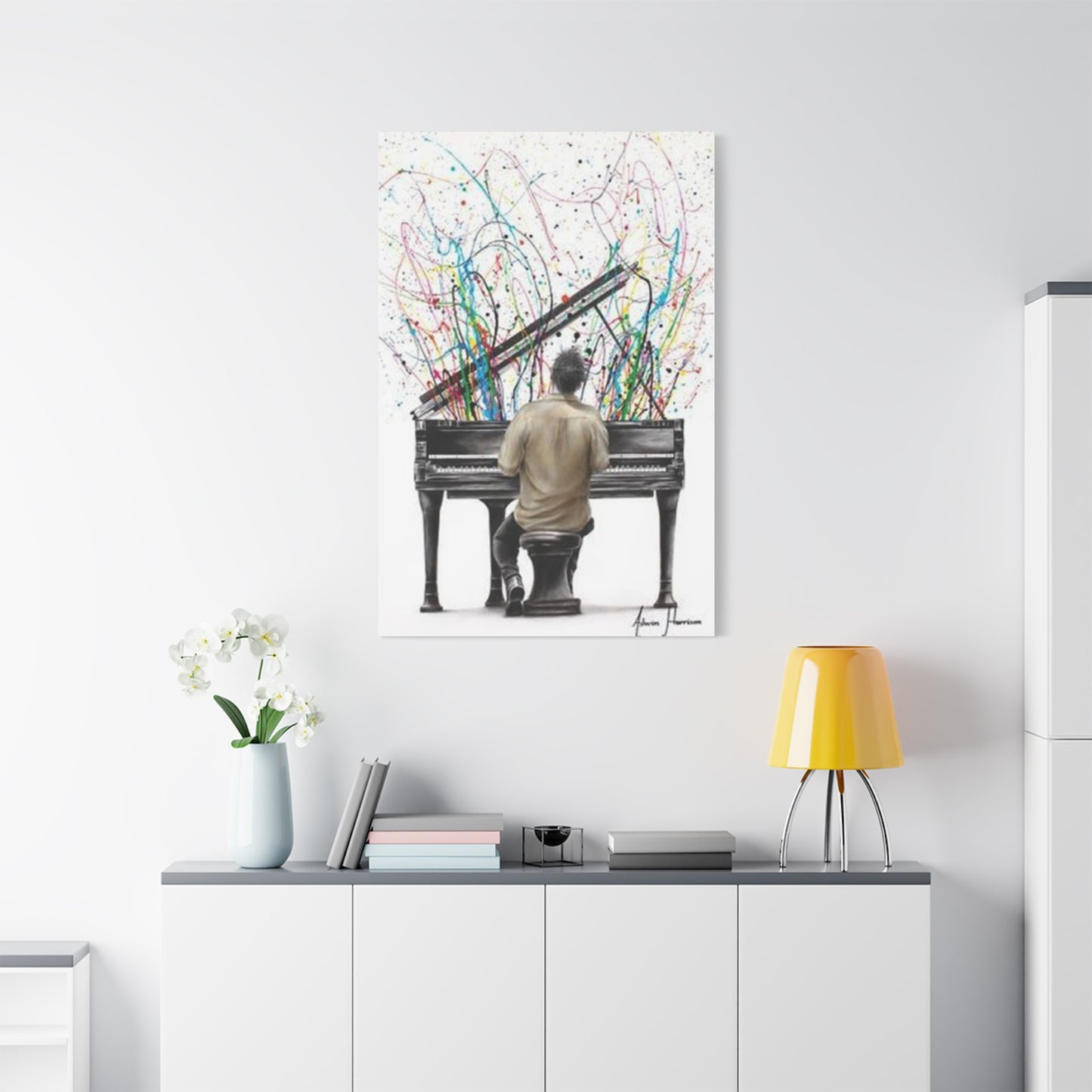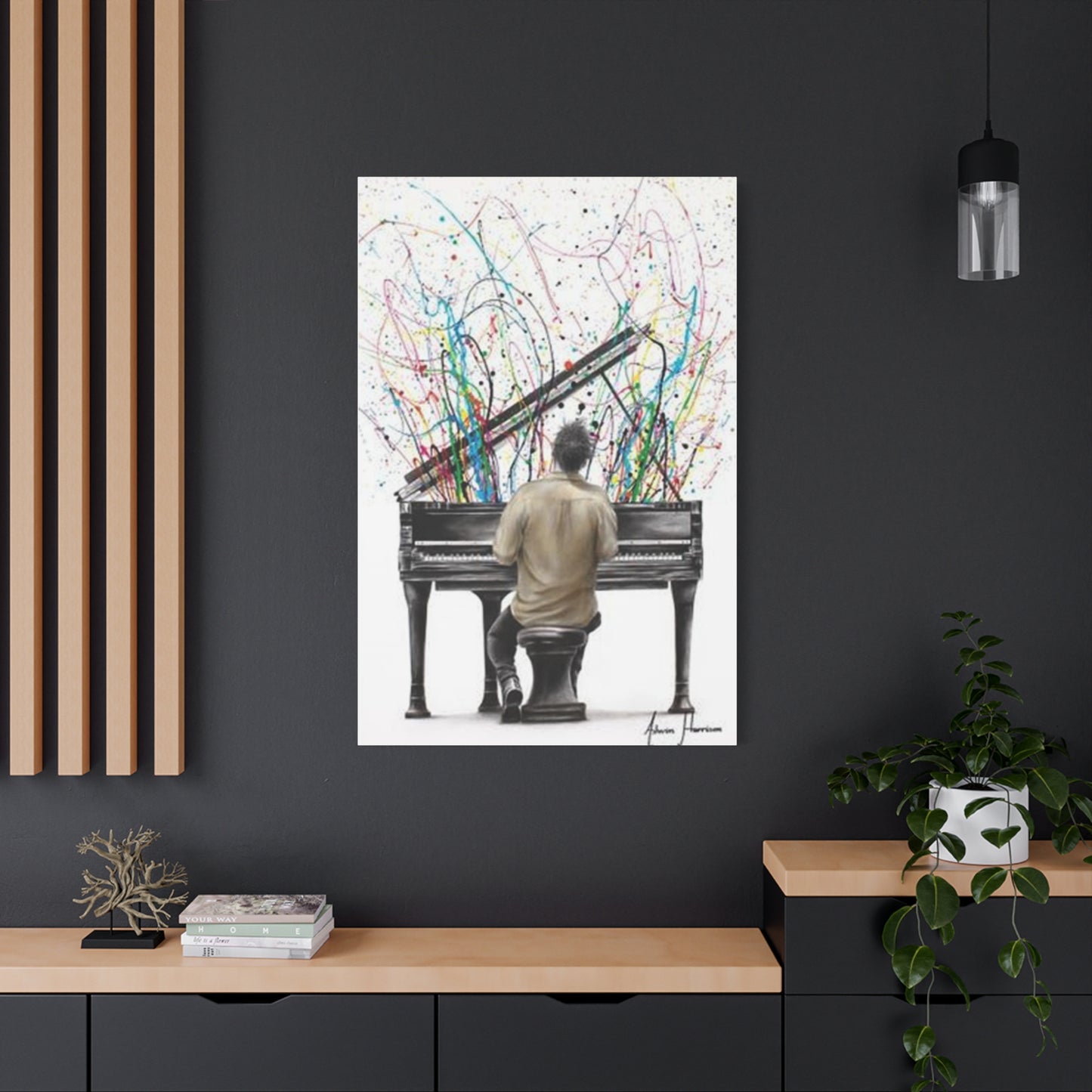Artist Playing Piano Painting Wall Art & Canvas Prints
Artist Playing Piano Painting Wall Art & Canvas Prints
Couldn't load pickup availability
Captivating Artist Playing Piano Painting Wall Art: Elevating Your Living Space with Musical Masterpieces
Music and visual arts have always shared an intimate connection, creating moments of profound beauty that resonate through time. When these two powerful forms of expression merge into a single piece, the result becomes something truly extraordinary. An artist playing piano painting wall art captures this magical intersection, bringing the soul-stirring essence of musical performance directly into your home. These remarkable artworks don't merely hang on walls—they breathe life into spaces, transforming ordinary rooms into galleries of emotion and sophistication.
The allure of such paintings lies in their ability to convey motion, passion, and artistry simultaneously. Whether depicting a classical pianist lost in concentration, a jazz performer swaying with rhythm, or a contemporary musician expressing raw emotion, these pieces serve as windows into moments of creative transcendence. The visual representation of someone immersed in playing piano creates an immediate emotional connection with viewers, evoking feelings of nostalgia, tranquility, or inspiration depending on the artistic interpretation.
The Profound Emotional Resonance Found Within Musical Artwork Representations
Paintings featuring pianists possess an inherent emotional depth that distinguishes them from other decorative pieces. The piano itself represents sophistication, dedication, and cultural refinement. When captured on canvas, the instrument becomes more than wood and keys—it transforms into a symbol of human expression and artistic devotion. The figure of an artist playing piano painting wall art communicates volumes without uttering a single sound, creating a silent symphony that viewers can almost hear.
These artworks tap into universal human experiences. Nearly everyone has encountered music that moved them deeply, whether at a concert, through recordings, or in personal memories. A well-executed painting of a pianist triggers these emotional associations, allowing viewers to project their own musical memories and feelings onto the artwork. This personal connection makes such pieces far more meaningful than generic decorative items.
The emotional impact intensifies when considering the concentration and vulnerability visible in musicians during performance. Artists who paint pianists often capture subtle details—the gentle arch of fingers over keys, the slight tilt of the head, the closed eyes signaling complete immersion in the music. These nuances communicate dedication, passion, and the transcendent state musicians enter during performance. Observing such moments frozen in paint allows viewers to appreciate the beauty of artistic devotion.
Furthermore, different artistic styles convey distinct emotional tones. Impressionistic renderings of pianists might emphasize the dreamy, flowing quality of music, with soft brushstrokes and muted colors suggesting gentle melodies. Conversely, bold expressionistic approaches might capture the raw power of performance through dramatic angles, intense colors, and dynamic compositions. This versatility ensures that artist playing piano painting wall art can match various emotional palettes and interior design schemes.
Exploring Diverse Artistic Styles That Bring Piano Performances to Life
The beauty of piano-themed artwork lies in its adaptability across countless artistic movements and styles. Each approach offers unique advantages and appeals to different aesthetic sensibilities, ensuring that everyone can find a piece that resonates with their personal taste and complements their living environment.
Classical realism presents pianists with photographic precision, capturing every detail from the grain of the piano's wood to the subtle shadows cast by fingers on ivory keys. These paintings appeal to traditionalists who appreciate meticulous craftsmanship and lifelike representation. The hyperrealistic approach allows viewers to study every element of the scene, creating an almost voyeuristic experience of witnessing an intimate performance moment.
Impressionism offers a softer, more atmospheric interpretation. These works prioritize mood and light over precise details, using loose brushstrokes and luminous colors to suggest rather than define forms. An impressionist artist playing piano painting wall art might show a pianist bathed in golden afternoon light, with colors blending harmoniously to evoke feelings of warmth and nostalgia. This style works beautifully in spaces seeking a gentle, contemplative atmosphere.
Abstract approaches deconstruct the piano and pianist into shapes, colors, and lines that represent the essence of music rather than its literal appearance. Geometric forms might suggest piano keys, while swirling patterns convey melodic movement. These pieces appeal to modern sensibilities and work exceptionally well in contemporary spaces, offering visual interest without demanding representational accuracy.
Expressionism captures the intense emotional experience of both performing and hearing music. Bold colors, distorted forms, and dramatic compositions convey passion and energy. An expressionist painting of a pianist might feature exaggerated hand positions, vibrant unrealistic colors, and dynamic brushwork that seems to pulse with musical rhythm. These powerful pieces become focal points in any room, commanding attention and sparking conversation.
Vintage and retro styles evoke nostalgia for specific eras, whether depicting jazz pianists in smoky 1920s clubs or classical performers in ornate concert halls. These period-specific representations appeal to history enthusiasts and those seeking to create themed interior spaces. The historical context adds layers of meaning, connecting present-day viewers with musical traditions spanning decades or centuries.
Strategic Placement Considerations for Maximum Visual Impact in Your Home
Positioning your artist playing piano painting wall art strategically maximizes its aesthetic impact while ensuring it enhances rather than overwhelms your space. The location you choose should consider factors including lighting, room function, existing decor, and the painting's size and style.
Living rooms represent ideal locations for these artworks, particularly above sofas or fireplace mantels. These gathering spaces benefit from conversation-starting pieces that reflect the homeowner's cultural interests and aesthetic preferences. A large-scale piano painting can anchor an entire seating area, providing a sophisticated focal point that draws the eye and establishes the room's ambiance. When placed above a sofa, ensure the artwork's width spans approximately two-thirds to three-quarters of the furniture's length for proper visual balance.
Music rooms or home studios gain obvious thematic coherence from piano-themed artwork. If you play instruments yourself, surrounding your practice space with inspiring visual representations of musicians can enhance motivation and create an environment conducive to creativity. These paintings remind musicians of the beauty they strive to create, serving as daily inspiration during practice sessions.
Home offices benefit from artwork that promotes concentration and creativity. A painting of a focused pianist can subconsciously encourage similar dedication and attention in your own work. Choose pieces with calmer color palettes and compositions for workspaces to avoid overstimulation while still providing visual interest during breaks or moments of contemplation.
Dining rooms offer another excellent location, particularly for pieces depicting elegant performances or vintage scenes of musicians. The sophisticated associations with piano music complement the social and refined nature of dining spaces. A well-chosen painting can elevate dinner parties and family meals, contributing to an atmosphere of cultured enjoyment.
Bedrooms require more careful consideration, as artwork in these intimate spaces directly influences mood and relaxation. Gentler interpretations of pianists—perhaps impressionist pieces with soft colors or serene classical scenes—work better than dramatic, energetic compositions. The artwork should promote tranquility rather than stimulation, supporting the room's primary function as a rest sanctuary.
Hallways and entryways frequently get overlooked but offer valuable wall space for art. A striking artist playing piano painting wall art in an entrance creates immediate impressions for guests, establishing your home's cultural character from the moment they arrive. Vertical compositions work particularly well in narrow hallway spaces, drawing the eye upward and making corridors feel more spacious.
Lighting significantly affects how paintings appear, so consider both natural and artificial light sources. Avoid placing artworks where direct sunlight hits them for extended periods, as UV rays cause colors to fade over time. Instead, position pieces where they receive indirect natural light or install picture lights specifically designed for artwork illumination. Adjustable track lighting or wall-mounted fixtures allow you to highlight your painting's best features while creating dramatic shadows that enhance its dimensionality.
Color Palette Harmonization with Existing Interior Design Elements
Successfully incorporating an artist playing piano painting wall art into your space requires thoughtful consideration of color relationships between the artwork and surrounding decor. The painting's colors should either complement existing hues or provide intentional contrast that energizes the space without creating visual discord.
Monochromatic schemes involve selecting artwork that features variations of colors already present in your room. If your space showcases blue tones, choosing a painting with blue backgrounds or clothing would create harmonious continuity. This approach works beautifully in minimalist spaces where subtle sophistication takes precedence over bold statements. The result feels cohesive and carefully curated without appearing overly matched or sterile.
Analogous color schemes use hues adjacent on the color wheel, creating comfortable visual flow. If your room features warm tones like oranges and yellows, a painting incorporating reds, oranges, and golden browns would blend naturally while adding depth to the existing palette. This strategy maintains warmth or coolness consistent throughout the space while introducing enough variation to maintain interest.
Complementary contrasts involve pairing opposite colors on the color wheel—blue with orange, purple with yellow, green with red. A painting featuring these contrasting relationships creates visual excitement and becomes an immediate focal point. This approach works best in spaces needing energetic lift or dramatic statements. A predominantly blue room gains vibrancy from a painting featuring warm orange and gold tones highlighting the pianist and instrument.
Neutral foundations provide the most versatility for artwork placement. Rooms decorated primarily in whites, grays, blacks, and beiges allow paintings to shine without competing against existing colors. In these spaces, your artist playing piano painting wall art can feature any color palette you desire, from subdued earth tones to vibrant primaries, without creating clashes. Neutral rooms essentially become blank canvases that showcase artwork as intended.
Accent color reinforcement uses artwork to echo small pops of color elsewhere in the room. If your space features predominantly neutral tones with accent pillows or accessories in teal, selecting a painting that incorporates similar teal elements creates intentional connections throughout the space. This sophisticated approach demonstrates design awareness and makes rooms feel carefully considered rather than randomly assembled.
Consider the emotional associations of colors when selecting your painting. Blues and greens typically evoke calmness and serenity, ideal for relaxation spaces. Warm reds, oranges, and yellows create energy and warmth, suitable for social areas. Purples suggest creativity and luxury, while earth tones convey stability and comfort. The pianist painting you choose should reinforce the emotional atmosphere you want to cultivate in each specific room.
Size Proportions That Create Balanced Visual Arrangements
Selecting appropriately sized artist playing piano painting wall art ensures your piece enhances rather than overwhelms or gets lost within your space. Proper proportions create visual balance that feels instinctively right, while incorrect sizing can make rooms appear awkward regardless of the artwork's quality.
For wall spaces above furniture like sofas, consoles, or beds, the artwork should generally span sixty to seventy-five percent of the furniture's width. A piece that's too small appears disconnected and insignificant, floating awkwardly on the wall without visual relationship to the furniture below. Conversely, artwork extending beyond the furniture's edges creates imbalance and can make the furniture appear crowded or diminished.
Large empty walls benefit from substantial pieces that command presence without requiring multiple smaller artworks. A single impressive piano painting measuring four to five feet wide makes a confident statement on an extensive blank wall. These dramatic pieces work particularly well in homes with high ceilings or open floor plans where smaller artworks would disappear. When selecting such substantial pieces, ensure adequate surrounding space—at least six inches of clearance from room boundaries or adjacent decorative elements.
Gallery wall arrangements offer alternatives for displaying multiple piano-themed pieces together. This approach works when you own several smaller paintings or want to combine your artist playing piano painting wall art with related pieces like musical instruments, concert scenes, or abstract musical representations. Plan gallery walls carefully, arranging pieces on the floor first to establish pleasing configurations before hanging. Maintain consistent spacing between pieces, typically two to three inches, for cohesive appearance.
Vertical versus horizontal orientation significantly impacts spatial perception. Vertical paintings draw eyes upward, making rooms feel taller—ideal for spaces with standard eight-foot ceilings. Horizontal pieces emphasize width, working well in narrow rooms or above long furniture pieces. Square formats provide versatility, working equally well in various spaces and offering balanced proportions that neither emphasize height nor width.
Consider viewing distance when selecting size. Larger rooms where viewers stand farther from walls require bigger artworks to maintain impact. Smaller, intimate spaces allow appreciation of smaller pieces where details remain visible from close proximity. A massive painting in a tiny room can feel oppressive, while a small delicate piece in a vast space disappears entirely.
The rule of thirds provides helpful guidance: artwork should occupy roughly one-third to one-half of the available wall space in that area. This proportion creates visual interest without dominating the entire wall. Multiple pieces can combine to fill this proportion, but individual pieces should respect these relationships for balanced appearance.
Frame Selection Strategies That Enhance Rather Than Distract
The frame surrounding your artist playing piano painting wall art plays a crucial role in presentation, either elevating the artwork or detracting from its impact. Thoughtful frame selection considers the painting's style, room decor, and the effect you want to achieve.
Traditional ornate frames suit classical realistic paintings and formal spaces. Gold leaf, carved wood, or elaborate molding complements the sophistication associated with piano performances and classical music. These frames work beautifully in traditionally decorated homes with antique furniture, rich fabrics, and formal arrangements. The ornate frame reinforces the painting's subject matter, creating cohesive visual storytelling that transports viewers to concert halls and refined musical salons.
Modern minimalist frames feature clean lines, simple profiles, and understated finishes. These frames suit contemporary paintings and modern interiors, allowing artwork to remain the focus without competing ornamentation. Slim metal frames in silver, gold, or black finishes provide just enough boundary definition without drawing attention away from the painting itself. This approach works particularly well with abstract or expressionist piano paintings where the artwork's boldness deserves center stage.
Wood frames offer warmth and versatility across various styles. Natural wood tones complement earth-toned paintings and casual spaces, while stained or painted wood frames can match any decor scheme. Distressed or weathered wood frames suit vintage piano paintings or rustic interiors, adding character and history to the presentation. The organic quality of wood creates approachable warmth compared to metal or highly ornate options.
Float frames create the illusion that paintings hover within the frame, with visible space between canvas edges and frame interior. This contemporary presentation style works beautifully with modern paintings and gallery-inspired spaces. Float frames draw attention to the painting's edges and depth, emphasizing its existence as a physical object rather than just imagery. This style particularly suits abstract or contemporary interpretations of pianists.
Matching versus contrasting frame choices depend on desired effects. Frames matching your room's existing trim, furniture, or decor create harmonious integration where artwork feels part of the overall design scheme. Contrasting frames make pieces stand out as distinct artistic statements. Neither approach is inherently superior—the choice depends on whether you want artwork to blend seamlessly or command attention as a separate element.
Custom framing allows perfect matching between artwork, frame, and space. While more expensive than ready-made options, custom framing ensures optimal presentation and protection for valuable pieces. Professional framers provide expertise in selecting appropriate materials, matting, and glazing options that preserve artwork while enhancing its appearance.
Matting decisions significantly impact presentation. Mats create breathing room between painting and frame, often enhancing smaller pieces by expanding their visual presence. Wide mats in neutral tones focus attention on artwork without introducing additional colors. However, some paintings benefit from frameless presentation or frames sitting directly against canvas edges, particularly large contemporary pieces where mats might diminish impact.
Material Quality Considerations for Long-Lasting Visual Appeal
The materials and production methods used in creating your artist playing piano painting wall art dramatically affect its longevity, appearance, and value. Understanding these factors helps you make informed purchasing decisions that balance budget constraints with quality expectations.
Original hand-painted canvases represent the pinnacle of artistic value. These unique creations carry the artist's literal hand throughout every brushstroke, making each piece truly one-of-a-kind. Original paintings appreciate in value over time, particularly when created by recognized artists. The texture, depth, and luminosity of hand-applied paint cannot be perfectly replicated through reproduction methods. If budget allows, investing in original artwork provides lasting satisfaction and potential financial return.
Giclee prints offer high-quality reproduction alternatives. This sophisticated printing method uses archival inks and museum-quality materials to create remarkably accurate reproductions of original paintings. Modern giclee technology captures subtle color variations, textures, and details with impressive fidelity. These prints on canvas or fine art paper provide affordable access to otherwise unattainable artworks. When properly displayed and cared for, giclee prints maintain their appearance for decades without significant fading or deterioration.
Canvas material choices range from cotton to linen to synthetic blends. Cotton canvas provides affordable durability and accepts paint or printing ink well. Linen canvas offers superior quality with tighter weave and smoother surface, preferred by many artists for original works. Synthetic canvases resist environmental factors like humidity better than natural fibers but may lack the organic character of traditional materials. Stretched canvas wrapped around wooden frames creates gallery-style presentation with painted edges that eliminate framing necessity.
Paper substrates work beautifully for certain artistic styles, particularly watercolors or prints emphasizing fine detail. Archival-quality paper resists yellowing and degradation over time. Weight measurements indicate thickness and durability—heavier papers (300gsm or higher) provide substantial feel and resist warping. Acid-free paper prevents degradation and color shifting that plague lower-quality materials.
Acrylic versus oil paint creates different visual and tactile effects in original paintings. Oil paints offer rich colors, smooth blending, and the traditional appearance associated with classical artwork. Acrylics dry quickly, resist yellowing, and provide vibrant contemporary appearance. Both mediums create beautiful results when skillfully applied, with choice often reflecting artist preference rather than quality differences.
Protective coatings shield paintings from environmental damage. Varnishes applied to original paintings protect against dust, moisture, and UV radiation while enhancing color vibrancy. Some varnishes add glossy finish while others maintain matte appearance. Glazing—glass or acrylic shields placed over framed artwork—provides additional protection, particularly important for valuable pieces. UV-filtering glazing prevents sun damage while museum glass eliminates glare for optimal viewing.
Canvas texture affects final appearance. Smooth fine-weave canvases suit detailed realistic paintings where texture might distract from imagery. Coarser textures add character and dimension, particularly effective in impressionistic or expressionistic works where visible weave becomes part of the artistic effect. Hand-textured surfaces created through paint application techniques add dimensional interest that flat reproductions cannot match.
Sourcing Authentic Piano-Themed Artworks from Reliable Venues
Finding the perfect artist playing piano painting wall art requires knowing where to look and how to evaluate options across various purchasing venues. Each source offers distinct advantages and considerations.
Online art marketplaces provide vast selection and convenient browsing. Major platforms connect buyers with artists worldwide, offering everything from affordable prints to original masterpieces. These venues typically include search filters for subject, style, size, color, and price, streamlining the selection process. Customer reviews and seller ratings help evaluate reliability and quality. However, viewing artwork only through screens presents challenges in accurately assessing colors, scale, and texture. Request detailed photographs or ask specific questions before purchasing significant pieces.
Gallery exhibitions offer the irreplaceable experience of viewing artwork in person. Local galleries frequently host shows featuring regional artists, allowing you to see pieces in three dimensions under proper lighting. Gallery staff provide expertise about artists, techniques, and provenance. Building relationships with galleries gives access to new works before public release and potentially negotiating purchase terms. While galleries typically charge higher prices than direct artist purchases, they provide curation, expertise, and established reputations that offer purchasing confidence.
Direct artist commissions enable complete customization. Working directly with painters allows you to request specific sizes, color palettes, compositional elements, or stylistic approaches that perfectly match your needs. Commissioned works become deeply personal, created specifically for your space and preferences. This option requires more time, typically several weeks to months depending on piece complexity. Establish clear agreements about expectations, timelines, pricing, and revision policies before beginning commissioned projects.
Art fairs and festivals gather numerous artists in single venues, allowing comparison shopping and discovering emerging talents. These events often feature more affordable pricing than established galleries while maintaining quality standards. Meeting artists personally provides insight into their creative processes and inspirations. Many art fairs occur seasonally, requiring planning to attend, but offer concentrated opportunities to view extensive artwork selections efficiently.
Interior design showrooms sometimes carry carefully curated art collections that complement their furniture and decor offerings. These pieces are selected specifically to work within coordinated design schemes, potentially simplifying your search. Designers on staff can advise about placement and coordination. However, selections may be more limited than dedicated art venues, and prices might include design consultation markups.
Estate sales and auctions occasionally yield remarkable finds, including vintage or antique piano paintings at fraction of retail costs. These venues require patience and luck but can reward persistent searchers with unique pieces carrying historical provenance. Carefully examine condition before bidding, as older paintings may need restoration. Understanding auction processes and setting firm budget limits prevents overspending in competitive bidding situations.
Print-on-demand services offer incredible affordability and customization. These platforms allow you to select from vast image libraries and order prints in your chosen size and format. While lacking the uniqueness of original art, these services provide accessible entry points for decorating on tight budgets. Quality varies significantly between providers, so research reputation and request samples when possible.
Caring for Your Investment Through Proper Preservation Practices
Proper care ensures your artist playing piano painting wall art maintains its beauty and value for years or decades. Simple preservation practices prevent damage and deterioration.
Environmental control significantly impacts artwork longevity. Maintain stable temperature and humidity levels—ideally 65-75 degrees Fahrenheit with 40-55 percent relative humidity. Extreme fluctuations cause canvas expansion and contraction, potentially cracking paint or loosening stretcher bars. Avoid hanging paintings near heating vents, air conditioning units, fireplaces, or exterior doors where temperature changes dramatically.
Sunlight exposure causes irreversible fading and damage. Direct sunlight particularly harms artwork, bleaching colors and yellowing varnishes or paper. Even indirect natural light causes gradual deterioration over time. Position paintings away from windows or use UV-filtering window treatments. If natural light exposure is unavoidable, rotate displayed artwork periodically, storing pieces in dark environments between display periods to minimize cumulative light damage.
Regular dusting prevents accumulation that dulls appearance and potentially damages surfaces. Use soft, clean, dry microfiber cloths or specialized art dusters with gentle wiping motions. Never use household dusting sprays or cleaning chemicals, which can damage paint or varnish. For canvas paintings, dust the back and frame as well, as accumulated debris can attract pests or hold moisture.
Handling artwork properly prevents accidental damage. Always hold framed pieces by the frame, never touching the canvas or painting surface. Wear clean cotton gloves when handling unframed works. Transport paintings carefully, protecting corners and faces with appropriate materials. Never carry multiple pieces simultaneously without proper support.
Professional cleaning and restoration should be performed by qualified conservators when necessary. If paintings develop serious issues like flaking paint, canvas tears, water damage, or significant discoloration, consult professionals rather than attempting repairs yourself. Improper intervention can worsen damage or destroy value. Regular professional inspections every few years help identify developing problems before they become severe.
Pest prevention protects artwork from insect damage. Certain pests attack canvas, paper, and wood frames. Maintain clean spaces around artwork, promptly address any pest issues in your home, and periodically inspect paintings for signs of infestation like small holes, frass, or unusual debris.
Proper storage for pieces not currently displayed prevents damage during non-display periods. Store paintings in climate-controlled environments away from basements or attics where temperature and humidity fluctuate severely. Keep pieces vertical rather than stacked flat, separated by acid-free tissue or bubble wrap. Avoid plastic wrap directly against painting surfaces, as trapped moisture encourages mold growth.
Combining Multiple Pieces for Cohesive Thematic Displays
Creating arrangements featuring multiple artworks adds complexity and visual interest beyond single-piece displays. When thoughtfully composed, these collections tell richer stories and create more dynamic visual experiences.
Thematic coherence provides organizational principle for multi-piece displays. Collections might focus exclusively on piano-related imagery, musical instruments broadly, or performance art across disciplines. This approach works beautifully in music rooms, studies, or dedicated gallery walls. The thematic connection creates intentional narrative that viewers appreciate discovering.
Stylistic consistency versus eclectic variety both offer valid approaches. Maintaining similar artistic styles—all impressionist pieces or all contemporary abstract works—creates harmonious unity that feels carefully curated. Alternatively, mixing styles adds energy and unexpected juxtaposition that sparks interest. The eclectic approach requires confident design sense to avoid appearing randomly assembled. Common elements like color palette, subject matter, or frame style can unify diverse pieces.
Size relationships within groupings require careful planning. Symmetrical arrangements featuring identically sized pieces create formal, organized appearance. Asymmetrical layouts with varied sizes feel more casual and dynamic. When mixing sizes, establish visual balance by imagining weight distribution—large pieces need balancing elements on opposite sides, though these might be multiple smaller pieces collectively matching the large work's visual impact.
Grid arrangements provide straightforward organization, particularly effective for matching-sized prints or photographs. These uniform layouts convey order and intention, working well in modern minimalist spaces. Maintain consistent spacing between pieces—typically two to three inches—for cohesive appearance. Grid arrangements work best when containing at least four pieces, as fewer items may appear incomplete.
Salon-style arrangements pack numerous pieces across entire walls with varied spacing and arrangements. This maximalist approach creates gallery atmosphere and works beautifully for extensive collections. Plan salon walls carefully, arranging pieces on the floor first to establish pleasing configurations before hanging. These dense displays work best in larger rooms where they won't feel overwhelming.
Linear horizontal arrangements work well in hallways or above long furniture pieces like sofas or console tables. Space pieces evenly in straight rows for formal appearance or vary heights slightly for relaxed feel. This format naturally guides eye movement along the line, creating visual flow that complements room circulation patterns.
Vertical stacking emphasizes height, making rooms feel taller. This arrangement works particularly well in spaces with limited horizontal wall space but adequate vertical clearance. Vertical galleries work beautifully flanking doorways, windows, or architectural features.
Central focal piece arrangements position your largest or most impressive artist playing piano painting wall art as the centerpiece, with smaller supporting pieces clustered around it. This asymmetrical approach creates clear visual hierarchy while allowing you to feature multiple works. The supporting pieces should relate thematically or stylistically to the focal piece without competing for attention.
The Symbolism and Cultural Significance Behind Piano Imagery
Understanding the deeper meanings associated with piano imagery enriches appreciation for artist playing piano painting wall art and informs selection decisions. These paintings carry cultural weight beyond mere decorative function.
Pianos symbolize refined culture and artistic achievement across many societies. Their presence in homes historically indicated wealth, education, and cultural sophistication. While modern accessibility has democratized piano ownership, the instrument retains associations with cultivation and intellectual refinement. Displaying piano-themed artwork reinforces these associations, suggesting the homeowner's appreciation for artistic excellence and cultural heritage.
The solitary nature of piano performance depicted in many paintings evokes themes of dedication, practice, and personal discipline. Pianists spend countless solitary hours perfecting their craft, and paintings capturing this private devotion resonate with anyone who has pursued mastery in any field. These images remind viewers that excellence requires sustained effort and passionate commitment.
Musical creation represents universal human expression transcending language and culture. Paintings depicting musicians celebrate this fundamental human capacity for creating beauty and meaning. An artist playing piano painting wall art acknowledges music's importance in human experience, honoring both musicians and the ineffable qualities that make music emotionally powerful.
Different musical genres carry distinct cultural associations. Classical piano performance evokes European cultural traditions, formal concert halls, and historical continuity with composers like Mozart, Beethoven, and Chopin. Jazz piano suggests American innovation, improvisation, and the cultural fusion that created uniquely American musical forms. Contemporary popular piano music connects with modern creative expression and evolving musical landscapes. The specific genre depicted influences the cultural conversations your artwork engages.
The relationship between performer and instrument depicted in paintings speaks to human-object interaction and the extension of human capability through tools. Pianos become extensions of musicians' creative intentions, intermediaries between internal musical imagination and external sonic reality. Paintings capturing this intimate relationship between artist and instrument celebrate human ingenuity and expressive capability.
Gender representation in piano paintings carries cultural significance. Historically, piano playing was encouraged for women as an accomplishing suitable to their social position, while professional concert performance remained predominantly male. Contemporary representations challenge or reinforce these historical patterns. Being aware of these dynamics adds dimension to artwork interpretation and selection.
The piano's physical presence—typically large, expensive, and immovable—represents permanence and stability. Unlike portable instruments, pianos anchor spaces and represent long-term commitment to musical practice. Artwork depicting pianos can symbolically reinforce these qualities of stability and enduring value in your home environment.
Commissioning Custom Artwork Tailored to Your Specific Preferences
Commissioning custom artist playing piano painting wall art allows you to obtain exactly what you envision rather than settling for available options. This process requires clear communication, patience, and understanding of collaborative creation.
Selecting the right artist represents your most important decision. Review portfolios carefully, paying attention to stylistic range, technical skill, and whether previous works resonate with your aesthetic sensibilities. Some artists specialize in specific styles or subjects, while others demonstrate versatility across approaches. Consider whether you want an artist who has previously created piano-themed works or one who will bring fresh perspective to the subject.
Establishing clear specifications before beginning prevents misunderstandings and disappointment. Provide detailed information about desired size, orientation, color preferences, stylistic approach, and any specific compositional elements you want included. Visual references help communicate your vision—collect examples of paintings whose colors, compositions, or styles appeal to you, even if they don't depict pianos. Explain what specifically attracts you to these references.
Discussing budget and timeline openly establishes realistic expectations. Custom artwork requires significant time investment, typically several weeks minimum depending on size and complexity. Rush orders may incur additional charges or compromise quality. Understand that skilled artists deserve fair compensation for their expertise and labor. While commissioned pieces cost more than prints or mass-produced art, you receive unique creations specifically designed for your needs.
Commission contracts protect both parties by documenting agreements. These documents should specify dimensions, medium, subject matter, number of included revisions, timeline, payment schedule, and what happens if either party becomes dissatisfied. Many artists request deposits before beginning work, with remaining payment due upon completion. Understand cancellation policies and revision limits before signing agreements.
Work-in-progress updates allow you to provide feedback during creation. Many artists share photographs at key stages—initial sketch, underpainting, midpoint, and near completion. This collaborative approach ensures the final piece matches your expectations while respecting the artist's creative process. Provide constructive, specific feedback rather than vague dissatisfaction. Remember that artists are creative professionals whose expertise you're hiring—trust their judgment while clearly communicating your preferences.
Revision expectations should be discussed upfront. Most commissions include limited revisions—typically one or two rounds of minor adjustments. Major compositional changes or complete restarts usually aren't included in base pricing. Be as clear as possible about your vision initially to minimize needed revisions.
Intellectual property considerations matter for some buyers. Typically, commissioning a painting gives you ownership of that physical object but not necessarily copyright to reproduce it. If you want rights to create prints or use the image commercially, negotiate this specifically and expect to pay more. Most residential buyers need only the physical painting, but clarify if your situation differs.
Pickup or delivery arrangements need coordination. Fragile artwork requires careful packaging for shipment. Discuss who bears responsibility for shipping costs and potential damage during transit. Local artists might offer personal delivery, allowing you to meet them and potentially see their studio.
Seasonal and Occasion-Based Display Strategies
While artist playing piano painting wall art typically serves as permanent decor, creative display strategies can make pieces feel fresh and relevant throughout the year or celebrate special occasions.
Rotating displays prevent visual fatigue and allow you to enjoy multiple pieces in the same space. If you own several piano paintings or musical artworks, periodically switching displayed pieces renews your space's appearance without purchasing new items. Rotation every few months provides novelty while allowing stored pieces to rest away from light exposure, extending their longevity.
Seasonal lighting adjustments affect how artwork appears. During darker winter months, enhanced artificial lighting makes paintings more visible and impactful. Summer's abundant natural light might require adjusting window treatments to prevent excessive sun exposure while still allowing artwork to be illuminated attractively. Seasonal daylight variations create opportunities to reposition portable lights or adjust display locations for optimal viewing.
Holiday decorating can complement rather than compete with permanent artwork. During festive seasons, incorporate decorative elements that reference or enhance your piano painting's themes. For example, if your artwork depicts classical performance, elegant holiday decorations in traditional colors might echo that sophistication. Sheet music used as decorative elements creates thematic connections to musical artwork. Avoid overwhelming artwork with excessive decorations—let pieces remain visible and appreciated even among seasonal additions.
Special occasions like recitals, concerts, or musical celebrations gain enhanced significance when held in spaces featuring musical artwork. If you host musicians or music students, your artist playing piano painting wall art reinforces the evening's theme and creates appropriate atmosphere. Position furniture and lighting to allow guests to appreciate both live performance and artistic representation of musical achievement.
Anniversary or memorial displays honor significant personal musical moments. If you or family members have meaningful musical histories—recitals, concerts, teaching careers, or passionate amateur practice—piano-themed artwork commemorates these experiences. Displaying such pieces alongside photographs, programs, or other memorabilia creates personal shrines celebrating musical involvement in your family's story.
Themed dinner parties or gatherings benefit from strategic artwork positioning. Hosting a classical music listening party or musician gathering gains atmospheric enhancement from well-placed piano paintings. Ensure artwork remains visible and well-lit, potentially becoming a conversation catalyst among guests who share musical interests.
Educational moments with children benefit from discussing displayed artwork. Use your piano painting as starting point for conversations about music, art, dedication, and cultural appreciation. Children exposed to quality artwork develop aesthetic sensibilities and cultural awareness. Point out details like hand positions, the pianist's expression, or artistic techniques used to create the painting.
Conclusion
Whether purchasing for purely decorative purposes or considering art as investment, understanding factors that determine artwork value helps you make informed decisions about artist playing piano painting wall art purchases.
Artist reputation significantly affects pricing and potential value appreciation. Works by established artists with exhibition histories, critical recognition, or gallery representation command higher prices but may appreciate over time. Emerging artists offer more affordable entry points, and astute collectors sometimes acquire works before artists gain widespread recognition, potentially benefiting from future appreciation.
Original versus reproduction dramatically affects value. Hand-painted original works are unique, limited to single pieces, and generally appreciate over time particularly when created by recognized artists. Limited edition prints have some scarcity value depending on edition size, while unlimited reproductions have primarily decorative value without investment potential. Understand which category your purchase falls into and price appropriately.
Provenance—documented history of ownership and exhibition—increases valuable works' worth. Paintings with clear ownership chains, exhibition histories in notable venues, or inclusion in published catalogues carry greater value than pieces with unknown histories. Maintain records of purchase, including receipts, certificates of authenticity, artist information, and any exhibition or publication documentation.
Condition critically impacts value. Pristine works command premium prices while damaged pieces sell at significant discounts. Professional restoration can improve condition but rarely restores full value to seriously damaged pieces. Examine potential purchases carefully for tears, paint loss, staining, foxing on paper, frame damage, or previous poor-quality repairs.
Size influences pricing, with larger works typically commanding higher prices due to greater material costs and time investment. However, extremely large pieces may have limited market appeal due to display space requirements, potentially affecting resale value. Mid-sized works often offer best balance between visual impact and practical versatility.
Technical execution quality separates master works from mediocre attempts. Skillful brushwork, sophisticated color harmonies, compelling composition, and faithful anatomical rendering in realistic styles all indicate quality. Even in abstract or expressionistic works, intentional mark-making differs from sloppy execution. Developing ability to recognize quality helps you select pieces likely to provide lasting satisfaction.
Share
